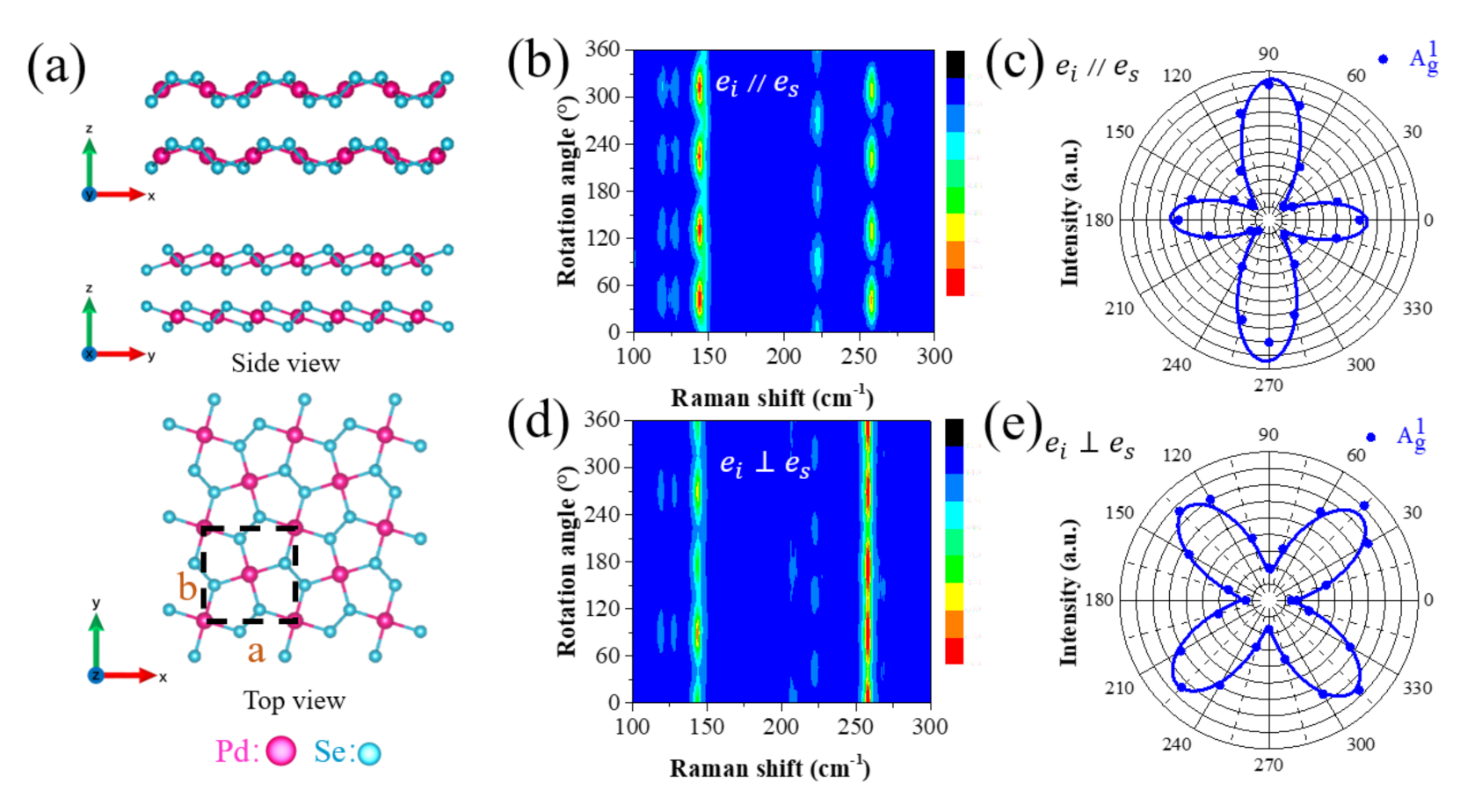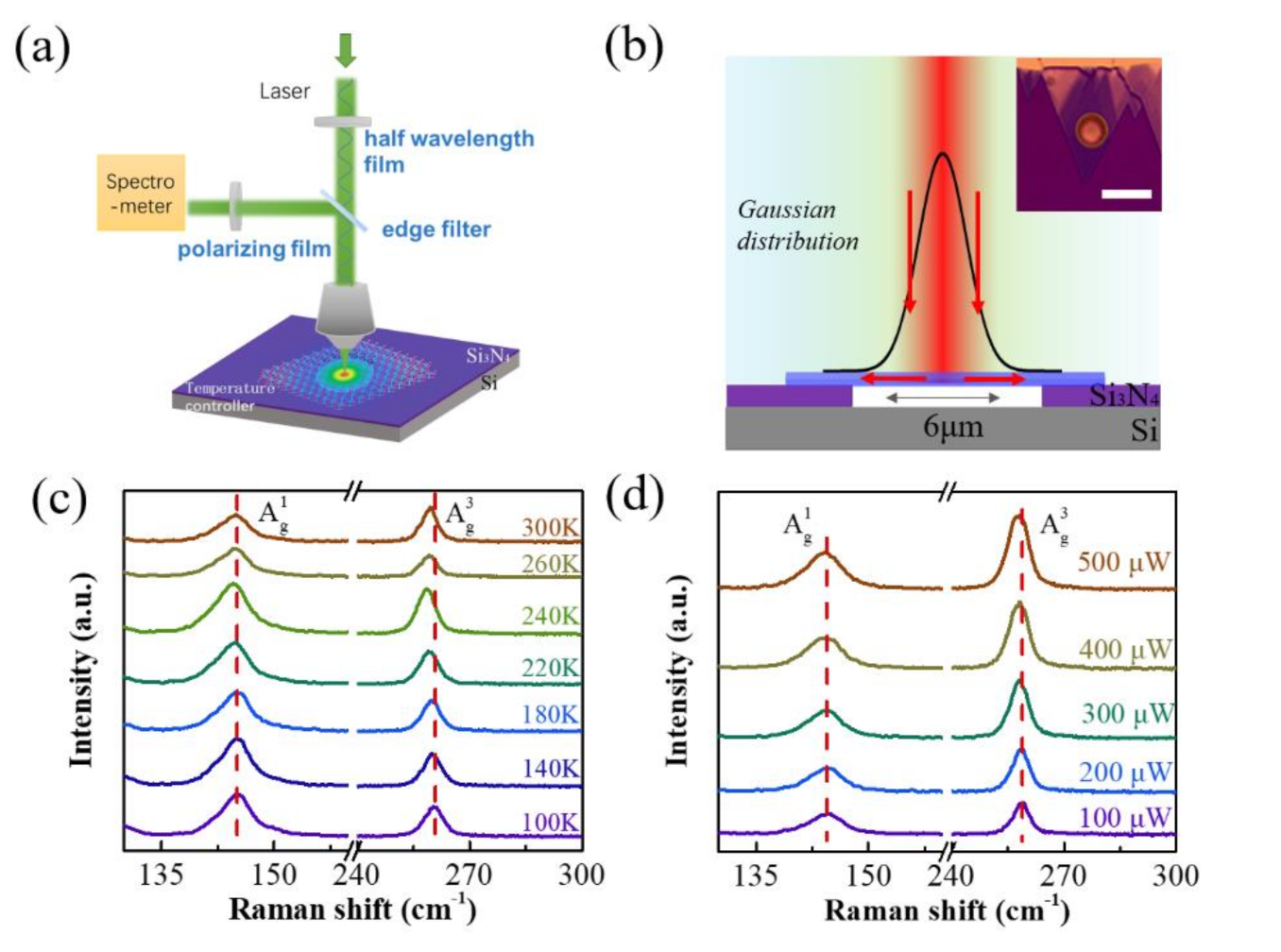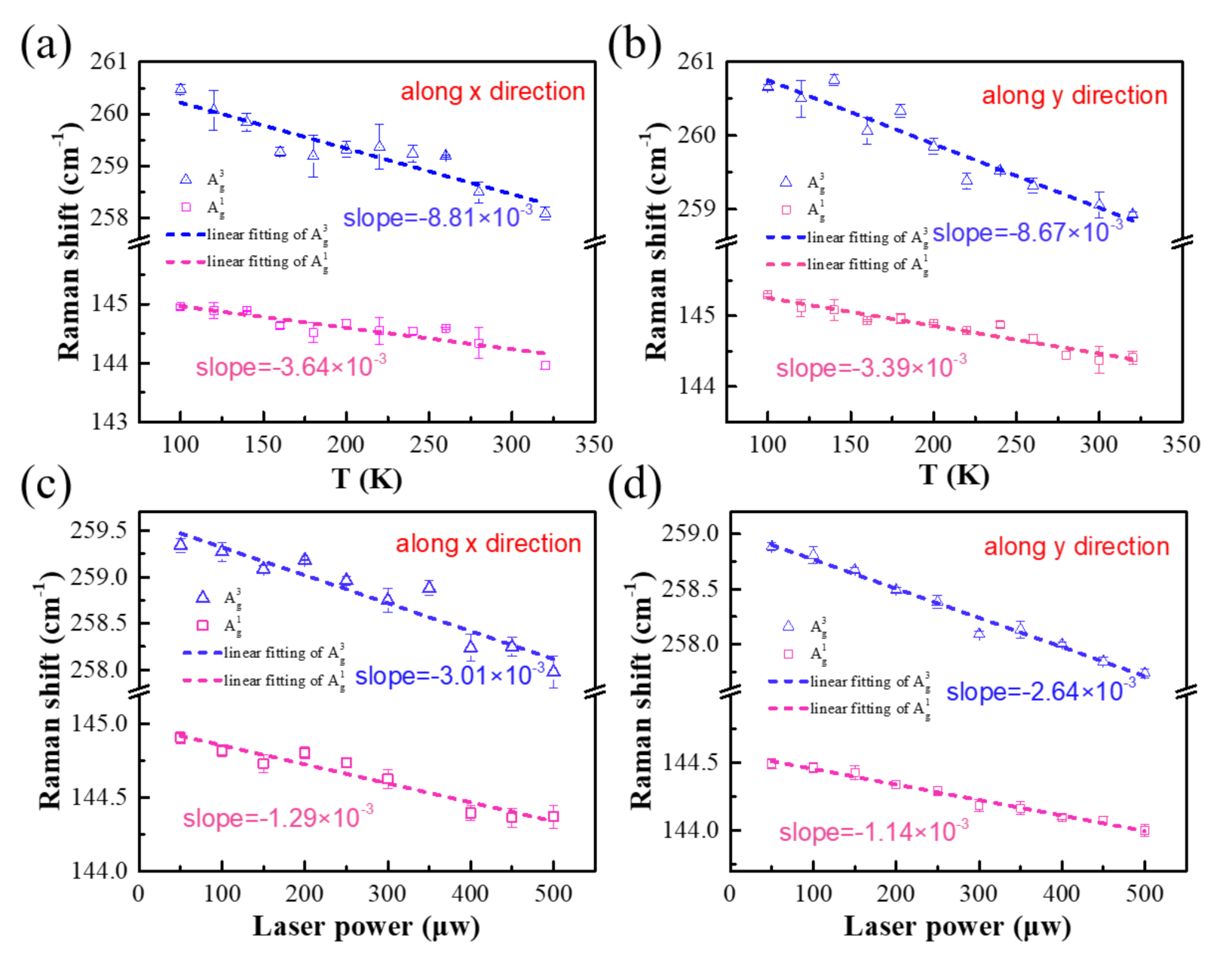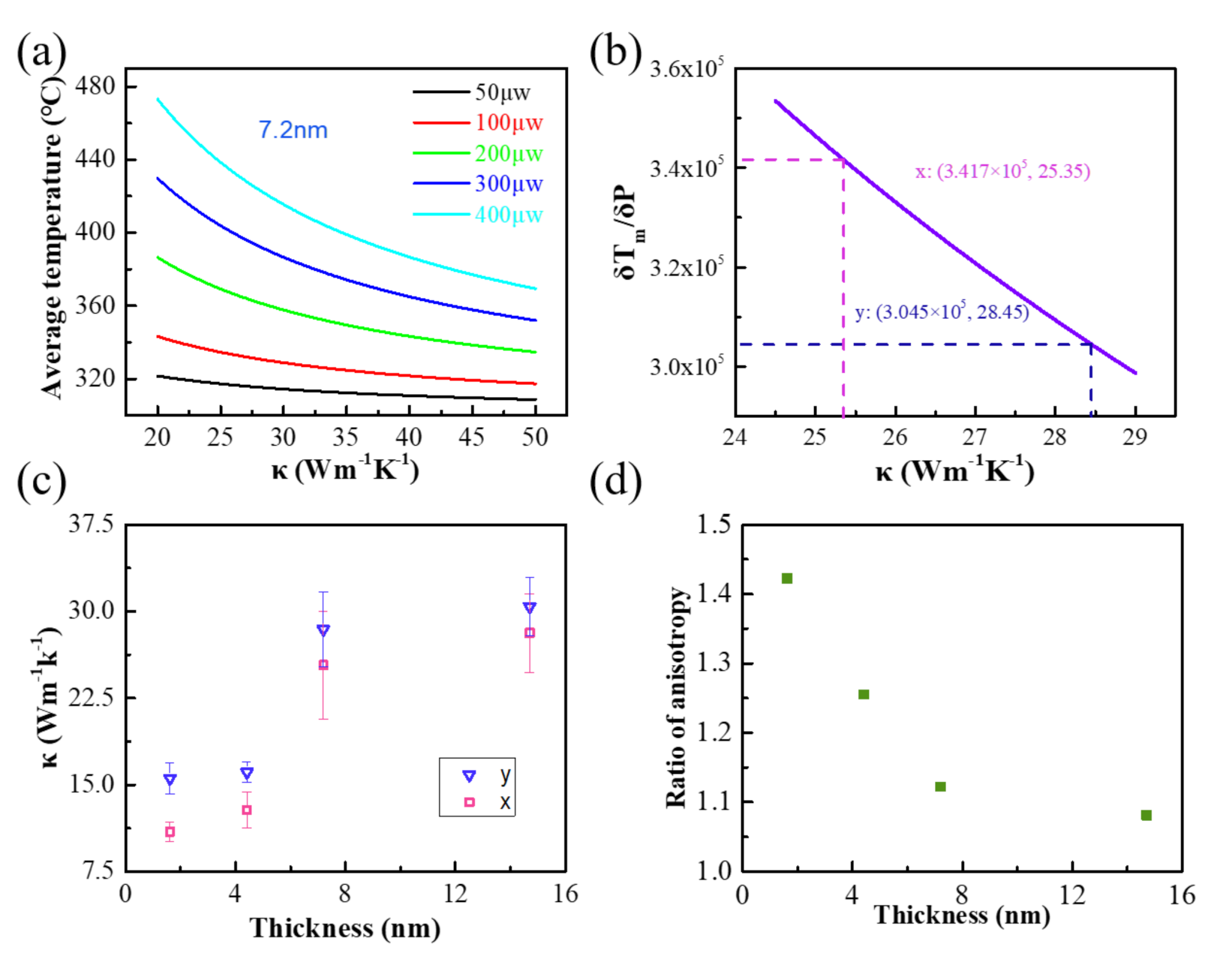In-Plane Anisotropic Thermal Conductivity of Low-Symmetry PdSe2
Abstract
1. Introduction
2. Materials and Methods
3. Results and Discussion
4. Conclusions
Supplementary Materials
Author Contributions
Funding
Institutional Review Board Statement
Informed Consent Statement
Data Availability Statement
Conflicts of Interest
References
- Novoselov, K.S.; Geim, A.K.; Morozov, S.V.; Jiang, D.; Zhang, Y.; Dubonos, S.V.; Grigorieva, I.V.; Firsov, A.A. Electric Field Effect in Atomically Thin Carbon Films. Science 2004, 306, 666–669. [Google Scholar] [CrossRef]
- Wang, Q.H.; Kalantar-Zadeh, K.; Kis, A.; Coleman, J.N.; Strano, M.S. Electronics and optoelectronics of two-dimensional transition metal dichalcogenides. Nat. Nanotechnol. 2012, 7, 699–712. [Google Scholar] [CrossRef]
- Li, L.; Han, W.; Pi, L.; Niu, P.; Han, J.; Wang, C.; Su, B.; Li, H.; Xiong, J.; Bando, Y.; et al. Emerging in—Plane anisotropic two—Dimensional materials. InfoMat 2019, 1, 54–73. [Google Scholar] [CrossRef]
- Ma, W.; Shabbir, B.; Ou, Q.; Dong, Y.; Chen, H.; Li, P.; Zhang, X.; Lu, Y.; Bao, Q. Anisotropic polaritons in van der Waals materials. InfoMat 2020, 2, 777–790. [Google Scholar] [CrossRef]
- Ciarrocchi, A.; Avsar, A.; Ovchinnikov, D.; Kis, A. Thickness-modulated metal-to-semiconductor transformation in a transition metal dichalcogenide. Nat. Commun. 2018, 9, 919. [Google Scholar] [CrossRef] [PubMed]
- Wang, Y.; Li, L.; Yao, W.; Song, S.; Sun, J.T.; Pan, J.; Ren, X.; Li, C.; Okunishi, E.; Wang, Y.Q.; et al. Monolayer PtSe2, a New Semiconducting Transition-Metal-Dichalcogenide, Epitaxially Grown by Direct Selenization of Pt. Nano Lett. 2015, 15, 4013–4018. [Google Scholar] [CrossRef]
- Oyedele, A.D.; Yang, S.; Liang, L.; Puretzky, A.A.; Wang, K.; Zhang, J.; Yu, P.; Pudasaini, P.R.; Ghosh, A.W.; Liu, Z.; et al. PdSe2: Pentagonal Two-Dimensional Layers with High Air Stability for Electronics. J. Am. Chem. Soc. 2017, 139, 14090–14097. [Google Scholar] [CrossRef] [PubMed]
- Liang, Q.; Wang, Q.; Zhang, Q.; Wei, J.; Lim, S.X.; Zhu, R.; Hu, J.; Wei, W.; Lee, C.; Sow, C.; et al. High-Performance, Room Temperature, Ultra-Broadband Photodetectors Based on Air-Stable PdSe2. Adv. Mater. 2019, 31, 1807609. [Google Scholar] [CrossRef]
- Cheng, P.K.; Tang, C.Y.; Ahmed, S.; Qiao, J.; Zeng, L.H.; Tsang, Y.H. Utilization of group 10 2D TMDs-PdSe2 as a nonlinear optical material for obtaining switchable laser pulse generation modes. Nanotechnology 2021, 32, 055201. [Google Scholar] [CrossRef]
- Di Bartolomeo, A.; Pelella, A.; Liu, X.; Miao, F.; Passacantando, M.; Giubileo, F.; Grillo, A.; Iemmo, L.; Urban, F.; Liang, S.J. Pressure—Tunable Ambipolar Conduction and Hysteresis in Thin Palladium Diselenide Field Effect Transistors. Adv. Funct. Mater. 2019, 29, 1902483. [Google Scholar] [CrossRef]
- Li, L.; Wang, W.; Chai, Y.; Li, H.; Tian, M.; Zhai, T. Few-Layered PtS2 Phototransistor on h-BN with High Gain. Adv. Funct. Mater. 2017, 27, 1701011. [Google Scholar] [CrossRef]
- Liu, G.; Zeng, Q.; Zhu, P.; Quhe, R.; Lu, P. Negative Poisson’s ratio in monolayer PdSe2. Comput. Mater. Sci. 2019, 160, 309–314. [Google Scholar] [CrossRef]
- Lei, W.; Cai, B.; Zhou, H.; Heymann, G.; Tang, X.; Zhang, S.; Ming, X. Ferroelastic lattice rotation and band-gap engineering in quasi 2D layered-structure PdSe2 under uniaxial stress. Nanoscale 2019, 11, 12317–12325. [Google Scholar] [CrossRef]
- Hellgren, N.; Berlind, T.; Gueorguiev, G.K.; Johansson, M.P.; Stafström, S.; Hultman, L. Fullerene-like BCN thin films: A computational and experimental study. Mater. Sci. Eng. B 2004, 113, 242–247. [Google Scholar] [CrossRef]
- Goyenola, C.; Stafström, S.; Hultman, L.; Gueorguiev, A.G.K. Structural Patterns Arising during Synthetic Growth of Fullerene-Like Sulfocarbide. J. Phys. Chem. C 2012, 116, 21124–21131. [Google Scholar] [CrossRef]
- Zhang, G.; Amani, M.; Chaturvedi, A.; Tan, C.; Bullock, J.; Song, X.; Kim, H.; Lien, D.-H.; Scott, M.C.; Zhang, H.; et al. Optical and electrical properties of two-dimensional palladium diselenide. Appl. Phys. Lett. 2019, 114, 253102. [Google Scholar] [CrossRef]
- Jiang, S.; Xie, C.; Gu, Y.; Zhang, Q.; Wu, X.; Sun, Y.; Li, W.; Shi, Y.; Zhao, L.; Pan, S.; et al. Anisotropic Growth and Scanning Tunneling Microscopy Identification of Ultrathin Even-Layered PdSe2 Ribbons. Small 2019, 15, 1902789. [Google Scholar] [CrossRef] [PubMed]
- Yu, J.; Kuang, X.; Gao, Y.; Wang, Y.; Chen, K.; Ding, Z.; Liu, J.; Cong, C.; He, J.; Liu, Z.; et al. Direct Observation of the Linear Dichroism Transition in Two-Dimensional Palladium Diselenide. Nano Lett. 2020, 20, 1172–1182. [Google Scholar] [CrossRef]
- Zhong, J.; Yu, J.; Cao, L.; Zeng, C.; Ding, J.; Cong, C.; Liu, Z.; Liu, Y. High-performance polarization-sensitive photodetector based on a few-layered PdSe2 nanosheet. Nano Res. 2020, 13, 1780–1786. [Google Scholar] [CrossRef]
- Xu, W.; Jiang, J.; Ma, H.; Zhang, Z.; Li, J.; Zhao, B.; Wu, R.; Yang, X.; Zhang, H.; Li, B.; et al. Vapor phase growth of two-dimensional PdSe2 nanosheets for high-photoresponsivity near-infrared photodetectors. Nano Res. 2020, 13, 2091–2097. [Google Scholar] [CrossRef]
- Sun, J.; Shi, H.; Siegrist, T.; Singh, D.J. Electronic, transport, and optical properties of bulk and mono-layer PdSe2. Appl. Phys. Lett. 2015, 107, 153902. [Google Scholar] [CrossRef]
- Lan, Y.-S.; Chen, X.-R.; Hu, C.-E.; Cheng, Y.; Chen, Q.-F. Penta-PdX2 (X = S, Se, Te) monolayers: Promising anisotropic thermoelectric materials. J. Mater. Chem. A 2019, 7, 11134–11142. [Google Scholar] [CrossRef]
- Zhao, Y.; Yu, P.; Zhang, G.; Sun, M.; Chi, D.; Hippalgaonkar, K.; Thong, J.T.L.; Wu, J. Low—Symmetry PdSe2 for High Performance Thermoelectric Applications. Adv. Funct. Mater. 2020, 30, 2004896. [Google Scholar] [CrossRef]
- Qin, D.; Yan, P.; Ding, G.; Ge, X.; Song, H.; Gao, G. Monolayer PdSe2: A promising two-dimensional thermoelectric material. Sci. Rep. 2018, 8, 2764. [Google Scholar] [CrossRef] [PubMed]
- Sun, M.; Chou, J.P.; Shi, L.; Gao, J.; Hu, A.; Tang, W.; Zhang, G. Few-Layer PdSe2 Sheets: Promising Thermoelectric Materials Driven by High Valley Convergence. ACS Omega 2018, 3, 5971–5979. [Google Scholar] [CrossRef]
- Chen, Y.; Peng, B.; Cong, C.; Shang, J.; Wu, L.; Yang, W.; Zhou, J.; Yu, P.; Zhang, H.; Wang, Y.; et al. In-Plane Anisotropic Thermal Conductivity of Few-Layered Transition Metal Dichalcogenide Td-WTe2. Adv. Mater. 2019, 31, 1804979. [Google Scholar] [CrossRef]
- Wang, T.; Han, M.; Wang, R.; Yuan, P.; Xu, S.; Wang, X. Characterization of anisotropic thermal conductivity of suspended nm-thick black phosphorus with frequency-resolved Raman spectroscopy. J. Appl. Phys. 2018, 123, 145104. [Google Scholar] [CrossRef]
- Soini, M.; Zardo, I.; Uccelli, E.; Funk, S.; Koblmüller, G.; Fontcuberta i Morral, A.; Abstreiter, G. Thermal conductivity of GaAs nanowires studied by micro-Raman spectroscopy combined with laser heating. Appl. Phys. Lett. 2010, 97, 263107. [Google Scholar] [CrossRef]
- Luo, Z.; Maassen, J.; Deng, Y.; Du, Y.; Garrelts, R.P.; Lundstrom, M.S.; Ye, P.D.; Xu, X. Anisotropic in-plane thermal conductivity observed in few-layer black phosphorus. Nat. Commun. 2015, 6, 8572. [Google Scholar] [CrossRef]
- Huang, S.; Segovia, M.; Yang, X.; Koh, Y.R.; Wang, Y.; Ye, P.D.; Wu, W.; Shakouri, A.; Ruan, X.; Xu, X. Anisotropic thermal conductivity in 2D tellurium. 2D Mater. 2019, 7, 015008. [Google Scholar] [CrossRef]
- Puretzky, A.A.; Oyedele, A.D.; Xiao, K.; Haglund, A.V.; Sumpter, B.G.; Mandrus, D.; Geohegan, D.B.; Liang, L. Anomalous interlayer vibrations in strongly coupled layered PdSe2. 2D Mater. 2018, 5, 035016. [Google Scholar] [CrossRef]
- Zeng, L.-H.; Wu, D.; Lin, S.-H.; Xie, C.; Yuan, H.-Y.; Lu, W.; Lau, S.P.; Chai, Y.; Luo, L.-B.; Li, Z.-J.; et al. Controlled Synthesis of 2D Palladium Diselenide for Sensitive Photodetector Applications. Adv. Funct. Mater. 2019, 29, 1806878. [Google Scholar] [CrossRef]
- Grønvold, F.; Røst, E. The crystal structure of PdSe2 and PdS2. Acta Crystallogr. 1957, 10, 329–331. [Google Scholar] [CrossRef]
- Zhang, S.; Zhou, J.; Wang, Q.; Chen, X.; Kawazoe, Y.; Jena, P. Penta-graphene: A new carbon allotrope. Proc. Natl. Acad. Sci. USA 2015, 112, 2372–2377. [Google Scholar] [CrossRef] [PubMed]
- Li, X.; Meng, S.; Sun, J.-T. Emergence of d-orbital magnetic Dirac fermions in a MoS2 monolayer with squared pentagon structure. Phys. Rev. B 2020, 101, 144409. [Google Scholar] [CrossRef]
- Wu, P. The Study for Two-dimensional PtX2 (X = S Se Te) Which Have Geometrical Structures Fully Composed of Pentagons. IOP Conf. Ser. Mater. Sci. Eng. 2019, 631, 042010. [Google Scholar] [CrossRef]
- Yang, H.; Li, Y.; Yang, Z.; Shi, X.; Lin, Z.; Guo, R.; Xu, L.; Qu, H.; Zhang, S. First-principles calculations of the electronic properties of two-dimensional pentagonal structure XS2 (X = Ni, Pd, Pt). Vacuum 2020, 174, 109176. [Google Scholar] [CrossRef]
- Long, M.; Wang, Y.; Wang, P.; Zhou, X.; Xia, H.; Luo, C.; Huang, S.; Zhang, G.; Yan, H.; Fan, Z.; et al. Palladium Diselenide Long-Wavelength Infrared Photodetector with High Sensitivity and Stability. ACS Nano 2019, 13, 2511–2519. [Google Scholar] [CrossRef]
- Wang, J.; Zhou, Y.J.; Xiang, D.; Ng, S.J.; Watanabe, K.; Taniguchi, T.; Eda, G. Polarized Light-Emitting Diodes Based on Anisotropic Excitons in Few-Layer ReS2. Adv. Mater. 2020, 32, 2001890. [Google Scholar] [CrossRef]
- Li, L.; Wang, W.; Gong, P.; Zhu, X.; Deng, B.; Shi, X.; Gao, G.; Li, H.; Zhai, T. 2D GeP: An Unexploited Low-Symmetry Semiconductor with Strong In-Plane Anisotropy. Adv. Mater. 2018, 30, 1706771. [Google Scholar] [CrossRef]
- Sahoo, S.; Gaur, A.P.S.; Ahmadi, M.; Guinel, M.J.F.; Katiyar, R.S. Temperature-Dependent Raman Studies and Thermal Conductivity of Few-Layer MoS2. J. Phy. Chem. C 2013, 117, 9042–9047. [Google Scholar] [CrossRef]
- Araujo, F.D.V.; Oliveira, V.V.; Gadelha, A.C.; Carvalho, T.C.V.; Fernandes, T.F.D.; Silva, F.W.N.; Longuinhos, R.; Ribeiro-Soares, J.; Jorio, A.; Souza Filho, A.G.; et al. Temperature-dependent phonon dynamics and anharmonicity of suspended and supported few-layer gallium sulfide. Nanotechnology 2020, 31, 495702. [Google Scholar] [CrossRef] [PubMed]
- Cai, W.; Moore, A.L.; Zhu, Y.; Li, X.; Chen, S.; Shi, L.; Ruoff, R.S. Thermal transport in suspended and supported monolayer graphene grown by chemical vapor deposition. Nano Lett. 2010, 10, 1645–1651. [Google Scholar] [CrossRef] [PubMed]
- Pettes, M.T.; Maassen, J.; Jo, I.; Lundstrom, M.S.; Shi, L. Effects of surface band bending and scattering on thermoelectric transport in suspended bismuth telluride nanoplates. Nano Lett. 2013, 13, 5316–5322. [Google Scholar] [CrossRef]
- Peimyoo, N.; Shang, J.; Yang, W.; Wang, Y.; Cong, C.; Yu, T. Thermal conductivity determination of suspended mono- and bilayer WS2 by Raman spectroscopy. Nano Res. 2014, 8, 1210–1221. [Google Scholar] [CrossRef]
- Liu, H.; Yu, X.; Wu, K.; Gao, Y.; Tongay, S.; Javey, A.; Chen, L.; Hong, J.; Wu, J. Extreme In-Plane Thermal Conductivity Anisotropy in Titanium Trisulfide Caused by Heat-Carrying Optical Phonons. Nano Lett. 2020, 20, 5221–5227. [Google Scholar] [CrossRef]
- Jang, H.; Ryder, C.R.; Wood, J.D.; Hersam, M.C.; Cahill, D.G. 3D Anisotropic Thermal Conductivity of Exfoliated Rhenium Disulfide. Adv. Mater. 2017, 29, 1700650. [Google Scholar] [CrossRef]




| Material | Fabrication | Thickness (nm) | Method | In-Plane κ (W m−1 K−1) | Ratio | Resource | |
|---|---|---|---|---|---|---|---|
| Td-WTe2 | Exfoliation | 11.2 | Micro-Raman thermometry (MRT) | 0.639 | 0.743 | 1.16 | Ref. [26] |
| TiS3 | Exfoliation | 100 | Thermal bridge | 2.84 | 5.78 | 2.04 | Ref. [46] |
| Te | Solution phase syntheses | 100 | MRT | 1.7 | 2.15 | 1.26 | Ref. [30] |
| BP | Exfoliation | 9.5 | MRT | ~10 | ~20 | 2.00 | Ref. [29] |
| ReS2 | Exfoliation | 150 | Time-domaint hermoreflectance (TDTR) | 50 | 70 | 1.40 | Ref. [47] |
| PdSe2 | Exfoliation | 1.62 | MRT | 10.95 | 15.58 | 1.42 | This study |
Publisher’s Note: MDPI stays neutral with regard to jurisdictional claims in published maps and institutional affiliations. |
© 2021 by the authors. Licensee MDPI, Basel, Switzerland. This article is an open access article distributed under the terms and conditions of the Creative Commons Attribution (CC BY) license (https://creativecommons.org/licenses/by/4.0/).
Share and Cite
Chen, L.; Zhang, W.; Zhang, H.; Chen, J.; Tan, C.; Yin, S.; Li, G.; Zhang, Y.; Gong, P.; Li, L. In-Plane Anisotropic Thermal Conductivity of Low-Symmetry PdSe2. Sustainability 2021, 13, 4155. https://doi.org/10.3390/su13084155
Chen L, Zhang W, Zhang H, Chen J, Tan C, Yin S, Li G, Zhang Y, Gong P, Li L. In-Plane Anisotropic Thermal Conductivity of Low-Symmetry PdSe2. Sustainability. 2021; 13(8):4155. https://doi.org/10.3390/su13084155
Chicago/Turabian StyleChen, Lijie, Weitao Zhang, Hanlin Zhang, Jiawang Chen, Chaoyang Tan, Shiqi Yin, Gang Li, Yu Zhang, Penglai Gong, and Liang Li. 2021. "In-Plane Anisotropic Thermal Conductivity of Low-Symmetry PdSe2" Sustainability 13, no. 8: 4155. https://doi.org/10.3390/su13084155
APA StyleChen, L., Zhang, W., Zhang, H., Chen, J., Tan, C., Yin, S., Li, G., Zhang, Y., Gong, P., & Li, L. (2021). In-Plane Anisotropic Thermal Conductivity of Low-Symmetry PdSe2. Sustainability, 13(8), 4155. https://doi.org/10.3390/su13084155







